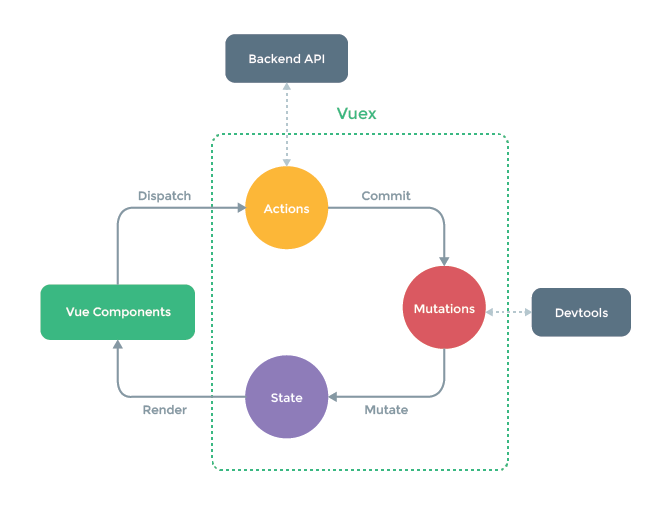前言:在使用vue开发的时候数据一版通过事件分发的方式进行,在vue1.x中组件中数据交互主要包含有:
子组件事件派发:$emit(向父级),$dispatch(沿着父级向上冒泡)
父组件通过$on监听到之后进行相应的操作
当有兄弟组件需要监听事件,父组件通过$broadcast向下广播。
vue2.x中取消了$dispatch,$broadcast,要实现组件之前的交互就非常蛋疼了,首先要不停的通过$emit派发到需要获取到这个事件的父级,然后父级通过$ref来调用相应的子组件的方法,单想想就容易心态爆炸。解决办法有2:
在根目录下data里新建一个vue对象作为eventHander,所有的事件通过这个新建的vue对象进行监听派发,具体就不进行描述了送上关键字:this.$root.eventHander.$on、this.$root.eventHander.$emit;
全局状态管理工具vuex,什么是vuex?借助官网的一句话:采用集中式存储管理应用的所有组件的状态,并以相应的规则保证状态以一种可预测的方式发生变化。;
vuex简介
借助一张图片,简短的对vuex的状态管理进行一个描述
从上图可以看出vuex主要包含actions、mutations、state
交互过程中,渲染:vue components根据state进行渲染,响应:通过触发actions相关事件调用mutations相关函数,mutations对state进行改变,state的改变引发vue components的重绘
状态的统一管理对大型项目提供了相当多的便利,数据的操作都可以通过vuex来进行,小型项目组件并不复杂,数据的交互层级不高,因此并不建议使用vuex进行数据交互
在对vuex进行描述之前送上vuex官网飞机票一张
核心概念之state
state里存储所有应用层级的信息。是作为唯一的一个数据源存在.
state定义
const store = new Vuex.Store({
state: {
count: 0
}
})
//上面的例子就定义了一个state,state存有一个变量count state获取
//网页直接通过script标签引入的方式不需要进行注册,模块化构建一定要进行Vue.use(Vuex)组件注册
//...state定义
//ps:注意,state相关数据是写在computed内,不是写在data内
new Vue({
el: '#app',
template: `<div class="app">{{count}}</div>`
computed: {
count() {
return this.$store.state.count
}
},
store
})
//首先将store注入到组件内部,调用可直接通过this.$store.state获取相应的值
//当数组需要获取多个状态值时this.$store.state前缀就需要写的很多,容易冗余,利用mapState辅助函数可以很好的解决这个问题
import { mapState } from 'vuex'
//在直接标签引入的情况下用mapState = vuex.mapState;
computed: mapState({
count: state => state.count,
countAlias: 'count',
// 为了能够使用 `this` 获取局部状态,必须使用常规函数,因为箭头函数会进行this绑定
countPlusLocalState (state) {
return state.count + this.localCount
}
})
//当映射的计算属性的名称与 state 的子节点名称相同时,我们也可以给 mapState 传一个字符串数组
computed: mapState([
// 映射 this.count 为 store.state.count
'count'
])
//当需要与当前组件属性共同使用的时候,可采用es6/7的对象展开符
computed: {
localComputed () { /* ... */ },
// 使用对象展开运算符将此对象混入到外部对象中
...mapState({
// ...
})
}
核心概念之mutations
更改store中的state的唯一方法就是通过mutation,每个mutation都像是一个事件监听,等待调用的观察者。其由一个事件类型和一个回调函数构成,回调函数对state进行修改,事件类型名称作为事件调用的名称;
//声明
const store = new Vuex.Store({
//...
mutations: {
increment (state) {
// 变更状态
state.count++
}
}
})
//唤起
store.commit('increment')
提交荷载
提交荷载可以理解为store.commit传递的额外参数
// ...
mutations: {
increment (state, n) {
state.count += n
}
}
store.commit('increment', 10)
//在大多数情况下,载荷应该是一个对象,这样可以包含多个字段并且记录的 mutation 会更易读:
// ...
mutations: {
increment (state, payload) {
state.count += payload.amount
}
}
store.commit('increment', {
amount: 10
})
//对象风格的提交方式
store.commit({
type: 'increment',
amount: 10
})
相应规则
最好提前在你的 store 中初始化好所有所需属性。
-
当需要在对象上添加新属性时,你应该
使用Vue.set(state.obj,'newProp','xxx')
state.obj = { ...state.obj, newProp: 123 }
使用常量代替mutation事件类型
这么做的好处是对state的操作接口一目了然,全部展现在mutation-types文件夹中,便于大项目的协作。当然这不是必须的。
// mutation-types.js
export const SOME_MUTATION = 'SOME_MUTATION'
// store.js
import Vuex from 'vuex'
import { SOME_MUTATION } from './mutation-types'
const store = new Vuex.Store({
state: { ... },
mutations: {
// 我们可以使用 ES2015 风格的计算属性命名功能来使用一个常量作为函数名
[SOME_MUTATION] (state) {
// mutate state
}
}
})
mutation必须是同步函数
因为异步函数会导致状态的不确定性,造成运行和调试的出路,这里就不进行展开了。
组件的mapMutations
import { mapMutations } from 'vuex'
export default {
// ...
methods: {
...mapMutations([
//type1
'increment' // 映射 this.increment() 为 this.$store.commit('increment')
]),
//type2
...mapMutations({
add: 'increment' // 映射 this.add() 为 this.$store.commit('increment')
})
}
}
核心概念之actions
上一章我们有提到mutation是没有异步操作的,因此异步操作需要用到action,注意action提交的mutation而不是直接处理state
const store = new Vuex.Store({
//...
actions: {
//context与store对象具有相同的方法和参数,但。。不是store本身
increment (context) {
context.commit('increment')
}
},
//也可以写成
actions: {
increment ({ commit }) {
commit('increment')
}
}
})
分发 Action
store.dispatch('increment');
//action同样支持荷载方式,和mutation差不多
// 以载荷形式分发
store.dispatch('incrementAsync', {
amount: 10
})
// 以对象形式分发
store.dispatch({
type: 'incrementAsync',
amount: 10
})
组件中分发 Action
import { mapActions } from 'vuex'
export default {
// ...
methods: {
...mapActions([
'increment' // 映射 this.increment() 为 this.$store.dispatch('increment')
]),
...mapActions({
add: 'increment' // 映射 this.add() 为 this.$store.dispatch('increment')
})
}
}
组合 Actions
因为action是异步的,因此组合多个action将是一个大问题,要解决这个问题这里引用了promise对象。通过dispath返回的promise对象进行操作,达成顺序执行
//A进行promise对象返回
actions: {
actionA ({ commit }) {
return new Promise((resolve, reject) => {
setTimeout(() => {
commit('someMutation')
resolve()
}, 1000)
})
}
}
//通过dispatch后的返回值执行异步操作
store.dispatch('actionA').then(() => {
// ...
})
//actions之间的互相调用
actions: {
// ...
actionB ({ dispatch, commit }) {
return dispatch('actionA').then(() => {
commit('someOtherMutation')
})
}
}
//也可以通过async/await属性组合(await只能在async函数内部运行)action:
actions: {
async actionA ({ commit }) {
commit('gotData', await getData())
},
async actionB ({ dispatch, commit }) {
await dispatch('actionA') // 等待 actionA 完成
commit('gotOtherData', await getOtherData())
}
}核心概念之getter
有时候我们需要从 store 中的 state 中派生出一些状态(即对state进行一些操作过后得到的状态),例如对列表进行过滤并计数:
//常规做法,当其他component需要用到时代码就会出现冗余
computed: {
doneTodosCount () {
return this.$store.state.todos.filter(todo => todo.done).length
}
}
//Vuex 允许我们在 store 中定义『getters』(可以认为是 store 的计算属性)。Getters 接受 state 作为其第一个参数
const store = new Vuex.Store({
state: {
todos: [
{ id: 1, text: '...', done: true },
{ id: 2, text: '...', done: false }
]
},
getters: {
doneTodos: state => {
return state.todos.filter(todo => todo.done)
}
}
})
//Getters 也可以接受其他 getters 作为第二个参数
getters: {
// ...
doneTodosCount: (state, getters) => {
return getters.doneTodos.length
}
}
store.getters.doneTodosCount // -> 1
//组件中使用
computed: {
doneTodosCount () {
return this.$store.getters.doneTodosCount
}
}mapGetters 辅助函数
和之前一样的辅助映射函数一毛一样
import { mapGetters } from 'vuex'
export default {
// ...
computed: {
// 使用对象展开运算符将 getters 混入 computed 对象中
...mapGetters([
'doneTodosCount',
'anotherGetter',
// ...
])
mapGetters({
// 映射 this.doneCount 为 store.getters.doneTodosCount
doneCount: 'doneTodosCount'
})
}
}
核心概念之module
使用单一状态树,导致应用的所有状态集中到一个很大的对象。但是,当应用变得很大时,store 对象会变得臃肿不堪。
Vuex 允许我们将 store 分割到模块(module)。每个模块拥有自己的 state、mutation、action、getters、甚至是嵌套子模块。
module定义
//状态篇
const moduleA = {
state: { ... },
mutations: { ... },
actions: { ... },
getters: { ... }
}
const moduleB = {
state: { ... },
mutations: { ... },
actions: { ... }
}
const store = new Vuex.Store({
modules: {
a: moduleA,
b: moduleB
}
})
store.state.a // -> moduleA 的状态
store.state.b // -> moduleB 的状态
module局部状态
对于模块内部的 mutation 和 getter,接收的第一个参数是模块的局部状态。
//即此状态为moduleA的state
const moduleA = {
state: { count: 0 },
mutations: {
increment (state) {
// state 模块的局部状态
state.count++
}
},
//对于模块内部的 getter,根节点状态会作为第三个参数:
getters: {
doubleCount (state, getters, rootState) {
return state.count * 2
}
}
},
// 同样,对于模块内部的 action,context.state 是局部状态,根节点的状态是 context.rootState这就是之前action的context不等于当前store对象的原因
actions: {
incrementIfOddOnRootSum ({ state, commit, rootState }) {
if ((state.count + rootState.count) % 2 === 1) {
commit('increment')
}
}
}
命名空间
模块内部的 action、mutation、和 getter 现在仍然注册在全局命名空间——这样保证了多个模块能够响应同一 mutation 或 action。你可以通过添加前缀或后缀的方式隔离各模块,以避免名称冲突。你也可能希望写出一个可复用的模块,其使用环境不可控。例如,我们想创建一个 todos 模块:
// types.js
// 定义 getter、action、和 mutation 的名称为常量,以模块名 `todos` 为前缀
export const DONE_COUNT = 'todos/DONE_COUNT'
export const FETCH_ALL = 'todos/FETCH_ALL'
export const TOGGLE_DONE = 'todos/TOGGLE_DONE'
// modules/todos.js
import * as types from '../types'
// 使用添加了前缀的名称定义 getter、action 和 mutation
const todosModule = {
state: { todos: [] },
getters: {
[types.DONE_COUNT] (state) {
// ...
}
},
actions: {
[types.FETCH_ALL] (context, payload) {
// ...
}
},
mutations: {
[types.TOGGLE_DONE] (state, payload) {
// ...
}
}
}

**粗体** _斜体_ [链接](http://example.com) `代码` - 列表 > 引用。你还可以使用@来通知其他用户。